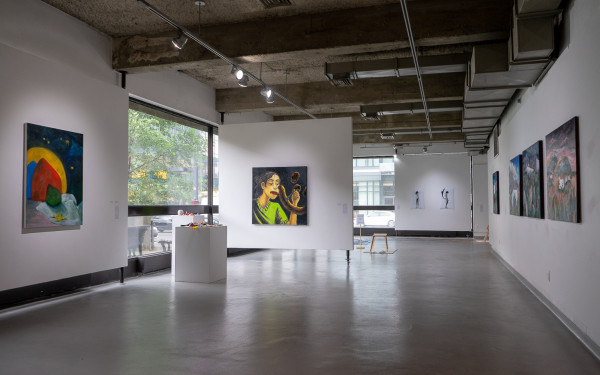Under an Exploding Sun
Mexican Art and the Borders of Identity
In a city where earthquakes crack open concrete streets to reveal cockroaches and Aztec secrets, where Modernist buildings stand beside temples with gold walls, and where dancers with feathered headdresses wear fluorescent sneakers, the contradictions in Mexico City are plentiful.
These paradoxical forces have fertilized the contemporary art scene here, which is brimming with biodiversity, violence and an evolving sense of identity.
I arrived at the Museo Universitario de Arte Contemporáneo after a long and strenuous voyage via the city’s expansive transit system—a sprawling, vibrant web of lines and symbols. The National Autonomous University of Mexico offers four separate bus lines to help students and visitors navigate through the campus that boasts 315,000 students and 30,000 faculty members. The largest university in the world, it is built on ancient, hardened volcanic rock overlooking the circular pyramids of Cuicuilco.
Nestled in the enormous green campus of UNAM, the MUAC opened its misted-glass doors to the public at the end of 2008. In true Mexico City spirit, the enormity of the gallery trumps the two disjointed galleries of Concordia University. In fact, MUAC contains nine separate galleries.
Much of the art in the first gallery dealt with themes of politics, identity, space and time. In a city of 21.2 million people and a country in the midst of a violent and bloody drug war, much of the art was full of anxiety and emitted a sense of unrest.
The exhibition, called Wandering Position, came about as a result of a donation of archived Mexican art works by inSite, an organization dedicated to the preservation of Mexican art. The result is something of an activated time capsule.
Dealing with “place based art practices,” the works open a dialogue on the “political-social context of the border phenomenon,” questioning ideals of space and identity.
Completely relevant to the present political climate, Wandering Position explores the border between Mexico and the United States, which is at the centre of a gruesome drug war. The art varied in medium and was connected by the works mocking sense towards Mexican power structures.
It was evident through the works that students are actively participating and questioning the failures of their government. Instead of offering solutions to these problems, they instead point them out.
One interesting piece was a balloon installation that would inflate and deflate to reveal political messages stitched onto the balloons. The sculpture seemed to play with ideas of political transparency and the idea of borders being something that both excludes and includes people.
The most impressive room contained the work of Cai Guo-Qiang’s Sunshine and Solitude. Guo-Qiang is considered one of the most important figures of the contemporary art scene to have emerged from post-revolutionary China. This exhibit, in particular, was Guo-Qiang’s interpretation of Mexico’s geographic identity.
Guo-Qiang’s work is characteristic in its chosen medium: gunpowder. The works that were featured in the gallery were created with the help of students and with the careful placement of gunpowder onto handmade paper. The fuses are lit to produce a series of controlled explosions on the surface of the paper that “fix” the image.
The gallery floor was flooded with volcanic rocks and there were two small “lakes” filled with the Mexican alcohol mezcal. Fourteen gunpowder drawings sprawled enormously across the walls and up the 20-foot ceilings to reveal elements of the Mexican landscape: mountains, flora and fauna and an immense, exploding sun.Another captivating room was that of Guatemalan artist Regina José Galindo, entitled Móvil. Much of her works dealt with themes of violence and femininity.
Violence is synonymous with the Guatemalan identity; however, Galindo’s works insist on an ethics of common memory.
Perhaps the most touching of works were her four framed locks of hair. The hair belonged to murdered women whose bodies had never been claimed. The works were created as an homage to these women.
Another stunning piece was a video of a woman having a plastic surgeon cover her body in blue felt marker to suggest where she would need work to obtain a “perfect body.” The lines drawn on her body was an act that was so bluntly obtrusive that the video was downright disturbing.
There was a real sense of community at the MUAC, one that extended beyond borders and one that attempted to make sense of identity within a climate of violence and fear. There were plenty of brochures, zines and postcards created by students that were offered free to visitors to take home with them.
I left the MUAC with a feeling that Mexican art is in the process of a revolution that involves an acute consciousness of technology, politics and how it transforms the self. All the art resonated with me in the sense that all the work seemed to deal with borders—geographic borders, the borders of politics, the borders of our bodies and, most importantly, the invisible borders that separate us from one another.
To see more photos from the MUAC, visit thelinknewspaper.ca
This article originally appeared in Volume 31, Issue 17, published January 4, 2011.

__900_675_90.jpg)
__900_675_90.jpg)
__900_675_90.jpg)
__900_623_90.jpg)
__900_675_90.jpg)
__900_592_90.jpg)
_600_832_s.png)

2_600_375_90_s_c1.jpg)
